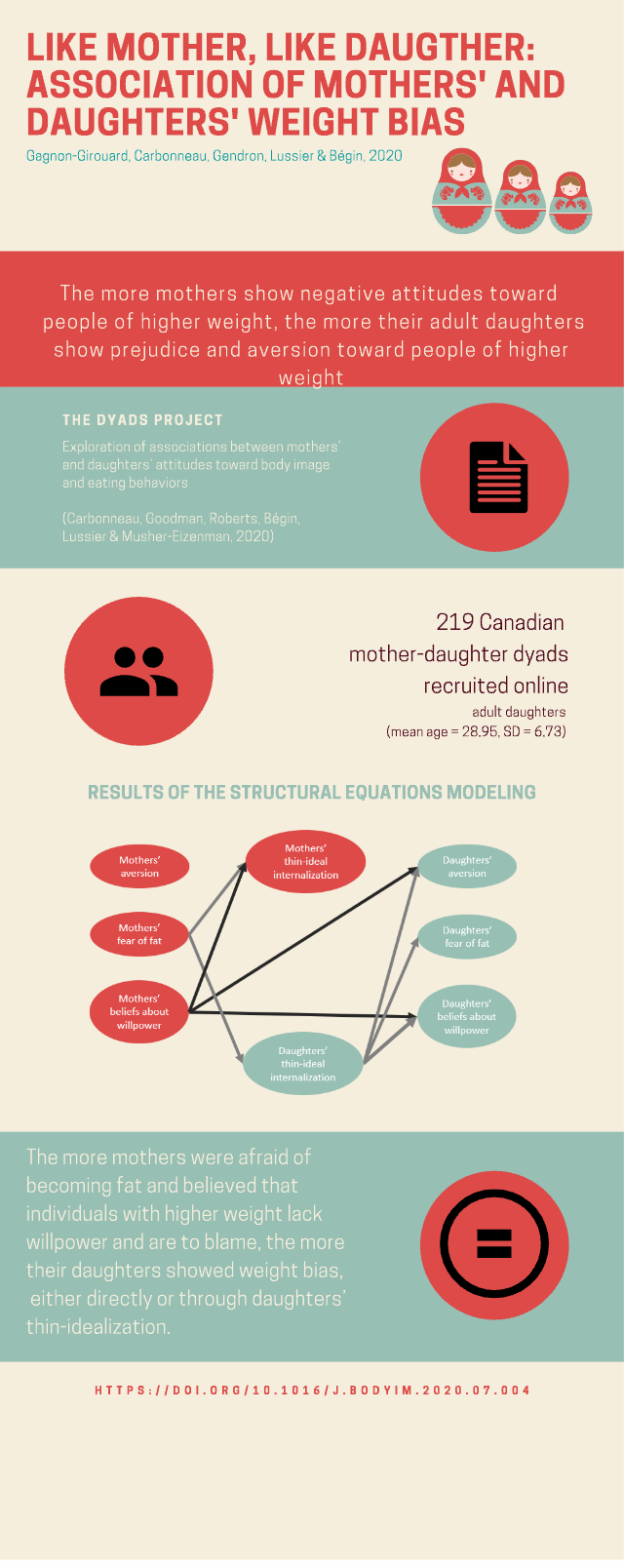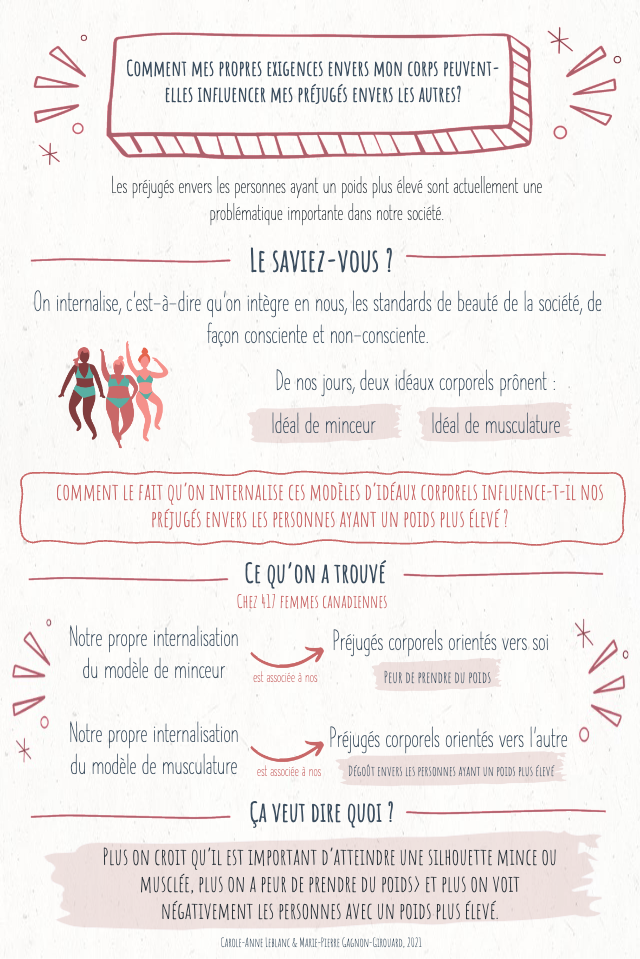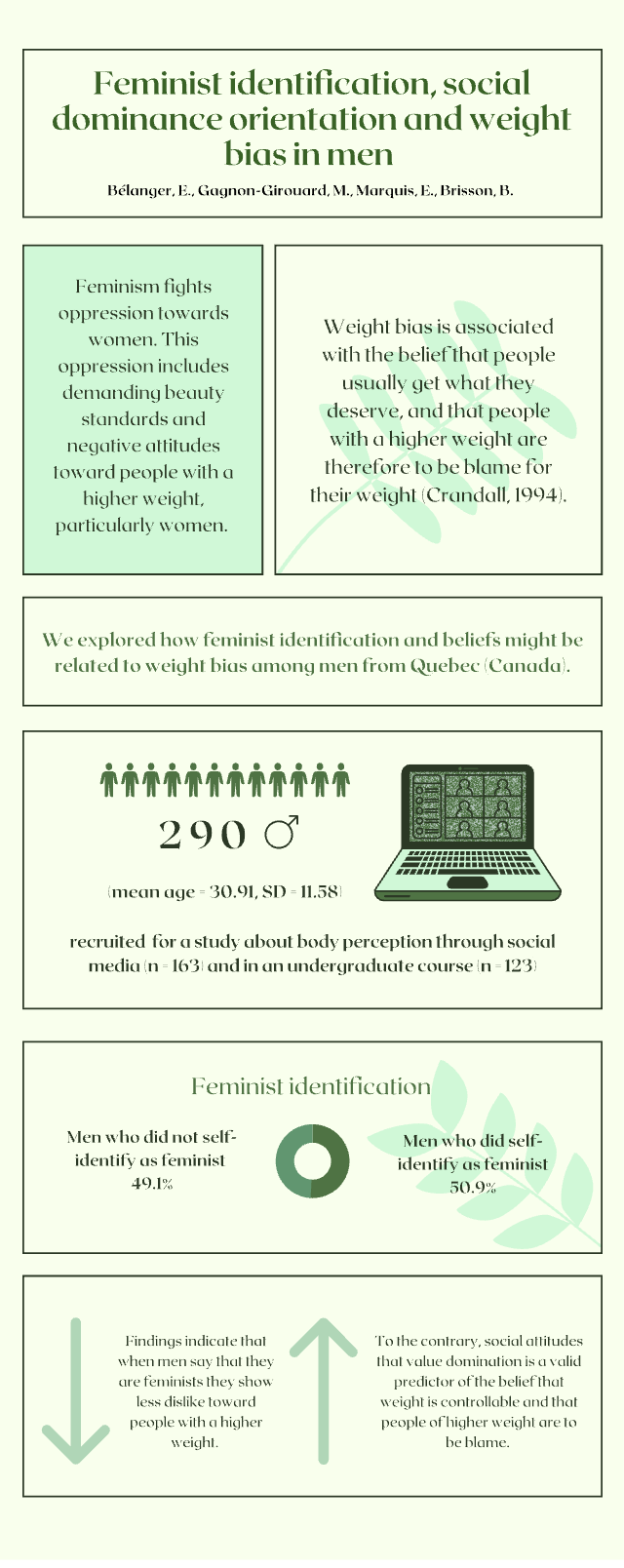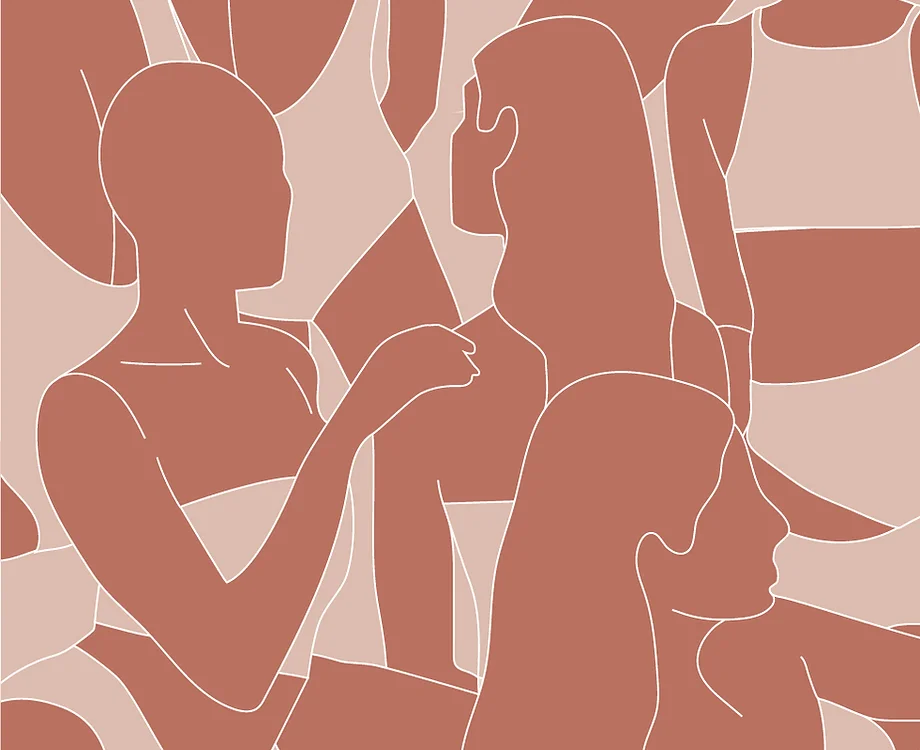Nos diffusions
Les médias sociaux : positifs ou négatifs sur la santé ? Profils d’utilisateurs dans un contexte d’exposition à du contenu positif quant à l’image corporelle
Contexte théorique. L’utilisation des médias sociaux a augmenté depuis la pandémie de COVID-19 (Kemp, 2020). Les interactions virtuelles portant sur l’apparence physique sont associées à une plus grande insatisfaction corporelle et à une plus grande stigmatisation liée au poids (Tiggeman et Barbato, 2018). En parallèle, le visionnement d’images empreintes de diversité corporelle ou des photos non retouchées pourrait favoriser la satisfaction corporelle (Tiggeman et Zinoviev, 2019). Objectif. Explorer les liens entre l’utilisation des médias sociaux, l’image corporelle et l’activité physique chez les participants à un projet portant sur l’exposition à du contenu positif quant à l’image corporelle sur les médias sociaux. Méthode. Au total, 262 participants (86,3% de femmes) recrutés pour une étude plus large via des publicités sur les médias sociaux ont répondu à des questionnaires en ligne qui évaluaient l’utilisation des médias sociaux et l’image corporelle. Résultats. La majorité des participants (79,4 %) désirent perdre du poids. La quasi-totalité (98,5 %) utilisent les médias sociaux, pour la plupart, plusieurs fois par jour (87,4 %). Les participantes trouvent que les médias sociaux nuisent à l’image corporelle (57,3 %). Plus l’utilisation des médias sociaux est fréquente, plus l’appréciation corporelle est faible (r = -0,16, p = 0,01) et plus l’activité physique intuitive est importante (r = 0,14, p = 0,03). Retombées. Cette étude montre que les médias sociaux semblent être une porte d’entrée adéquate pour un programme de prévention et de promotion de la santé, mais en n’oubliant pas qu’il y des effets positifs et négatifs quant à son utilisation.
Lemieux, V., Cassista, A. et Gagnon-Girouard, M-P.
Like mother, like daughter: Association of maternal negative attitudes towards people of higher weight with adult daughters’ weight bias
Negative weight bias emerges at an early age. Parents play an important role in the development of their children’s attitudes. In particular, mothers who place great importance on physical appearance have young daughters who exhibit more weight bias. The extent to which mothers have internalized the importance of being thin influences their own level of weight bias. Because most studies have been conducted among mothers of young children, the presence of these associations within adult dyads is unclear. The present study explored the link between mothers’ weight bias and their adult daughters’ weight bias, taking into account their respective level of thin-ideal internalization. Two hundred and nineteen Canadian mother-daughter adult dyads completed online questionnaires. Mothers’ beliefs about people of higher weight were significantly related to their daughters’ weight bias. Greater daughters’ thin-ideal internalization was associated with greater weight bias across all dimensions of bias. However, fear of getting fat was the only dimension of maternal bias associated with daughters’ thin-ideal internalization. In conclusion, adult daughters’ weight bias was modestly linked to their mothers’ negative attitudes toward individuals of higher weight.
Gagnon-Girouard, M. P., Carbonneau, N., Gendron, M., Lussier, Y., & Bégin, C. (2020). Like mother, like daughter: Association of maternal negative attitudes towards people of higher weight with adult daughters’ weight bias. Body Image, 34, 277-281. https://doi.org/https://doi.org/10.1016/j.bodyim.2020.07.004


THIN-IDEAL AND FIT-IDEAL INTERNALIZATION: DIFFERENTIAL ASSOCIATIONS WITH WEIGHT BIAS AND MOTIVATION TO PREJUDICE REGULATION
Weight stigma bears potential devastating consequences for individuals with a higher weight while leading everyone to fear weight gain. This study explores a psychosocial model of weight stigma among 430 Canadian adults recruited online. A structural equation model was tested where thin- and fit-ideal internalizations were linked to psychosocial mediators (social comparison, body image, motivation to control bias) and weight bias. Data adequately fit the model: 2 = 9.555, p = .298; CFI = 0.998; NFI = 0.990; RMSEA = 0.021 [0.000 – 0.063]. Thin-ideal internalization is related to fear of becoming fat (self-oriented weight bias) and beliefs about weight controllability directly and through body image and appearance comparison. Thin-ideal internalization is also indirectly related to aversion toward individuals of higher weight (other-oriented weight bias) through appearance comparison. Fit-ideal internalization is related to aversion toward higher-weight individuals, both directly and indirectly, through motivation to prejudice regulation, as well as the fear of becoming fat through body image. Findings suggest that the switch from a thin- to a fit-ideal might not be positive regarding weight stigma since it shows links to stronger negative affective attitudes toward people of higher weight and a lesser desire to control prejudice.
Leblanc, C-A., & Gagnon-Girouard, M-P.
Feminist identification, social dominance orientation, and weight bias in men
Weight bias has deleterious consequences on individuals considered overweight and has similarities with forms of prejudice linked to social dominance orientation (SDO). Feminism can counter oppression that women are subject to notably through weight bias and SDO, but no studies have focused directly on these variables among men, as feminist identity is linked to less endorsement of certain beliefs in SDO and weight bias. The purpose of the present study is to explore the associations between feminist identification and beliefs, SDO, and weight bias among men from Quebec. Participants were divided into four feminist identification groups. Results indicate that feminist identification in men is linked to lower levels of SDO and less dislike toward people considered overweight. Also, feminism seems to predict prejudice toward others, but not toward oneself whereas SDO-D seems to be a good predictor of the belief that weight is controllable.


FEMINISM, WEIGHT BIAS, AND MOTIVATION TO REGULATE PREJUDICE
Women are coerced by sociocultural norms into adhering to beauty standards that they must work hard to attain and maintain. In occidental societies, much value is placed on the thin beauty ideal, which is inextricably linked to health, happiness, success and feelings of self-worth, whereas having a higher weight is associated with laziness and lack of self-discipline. Because being thin is linked not only to beauty but also to moral value, weight bias is ubiquitous and socially acceptable. Feminism challenges women oppression and social injustice, and pushes back against socially imposed ideals such as beauty standards. Despite a number of significant studies on weight bias, none have focused specifically on feminism as a protective factor. This study aimed to explore the relationship between feminist self-labeling and beliefs, and weight bias, as well as the possible mediating effect of motivation to regulate prejudice, among 237 mostly French-speaking Canadian women aged 18 to 60. Findings suggest that feminist self-labeling and beliefs may have a greater protective effect on other- than on self- directed weight bias. Conversely, non-feminist beliefs are associated with greater weight bias of both types. Non-self-determined regulation does mediate the relationship between non-feminist beliefs and bias.
Marquis, Gagnon-Girouard, Bélanger, Carbonneau, Hamrouni, Ptito, & Brisson

